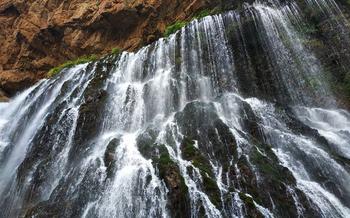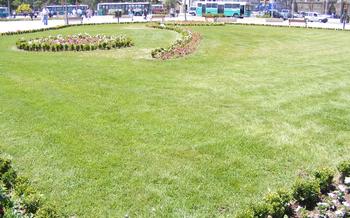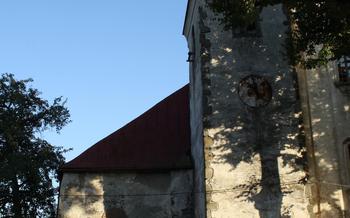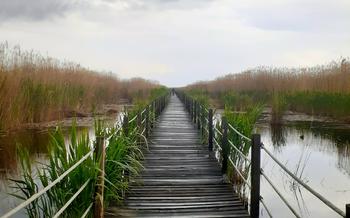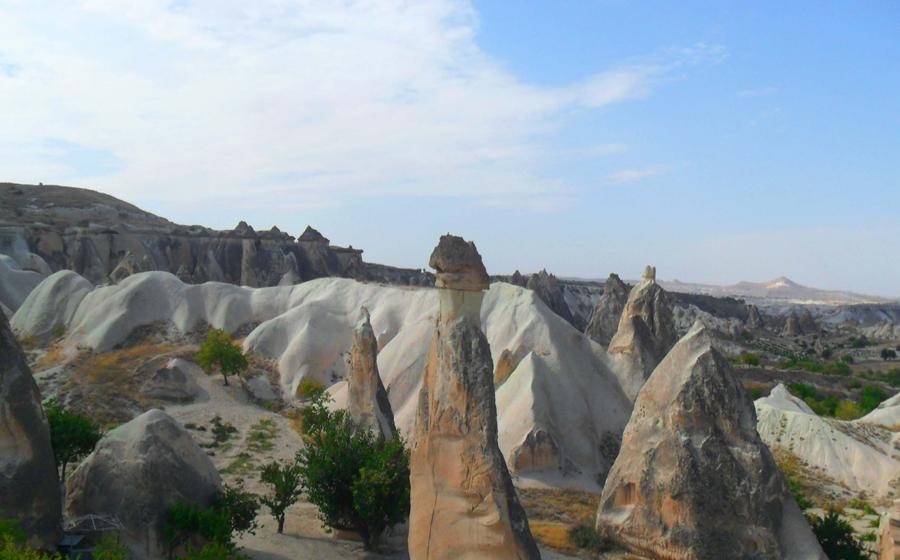
Güvercinlik Cave Church
- The Güvercinlik Cave Church: A Unique Historical and Religious Site
- Location and Accessibility: Getting to the Cave Church
- Admission and Visiting Hours: Planning Your Visit
- Exploring the Cave Church: What to Expect Inside
- History and Significance: Delving into the Past
- Restoration and Preservation: Protecting a Sacred Legacy
- Experiencing the Divine Liturgy: A Spiritual Journey
- Immerse in Local Culture: Beyond the Cave Church
- Discover Nearby Attractions: Enrich Your Journey
- Capture the Beauty: Photography Tips
- Respect and Etiquette: A Sacred Space
- Accommodation and Dining: Where to Stay and Eat
- Planning Your Trip: Essential Information
- Safety and Security: Ensuring a Smooth Visit
- Insider Tip: Unveiling a Hidden Gem
The Güvercinlik Cave Church: A Unique Historical and Religious Site
Nestled in the heart of Turkey's Cappadocia region, the Güvercinlik Cave Church stands as a testament to the enduring legacy of early Christianity and monasticism. Carved into a natural rock formation, this awe-inspiring sanctuary offers a glimpse into a bygone era, where faith and devotion took root in the most unexpected places.
The cave church's history dates back to the 10th century, a time when Cappadocia was a refuge for persecuted Christians. Seeking solace and seclusion, these early believers found refuge in the region's intricate network of caves and underground chambers. The Güvercinlik Cave Church, with its hidden location and natural camouflage, provided an ideal sanctuary for worship and contemplation.
Architecturally, the cave church exhibits a remarkable blend of Byzantine and Anatolian influences. Its interior is adorned with intricate frescoes and iconography, depicting biblical scenes and the lives of saints. The vaulted ceilings, carved niches, and intricate carvings add to the church's allure, creating an atmosphere of reverence and spirituality.
Beyond its historical and architectural significance, the Güvercinlik Cave Church holds deep religious meaning for both Christians and non-Christians alike. It serves as a reminder of the enduring power of faith, the resilience of the human spirit, and the profound impact of religion on the shaping of human history.
Location and Accessibility: Getting to the Cave Church
The Güvercinlik Cave Church is located in the heart of Cappadocia, in the province of Nevşehir, Turkey. This fascinating region is renowned for its unique geological formations, known as fairy chimneys, and its rich cultural heritage. To reach the cave church, visitors can take a scenic drive from the city of Nevşehir, which is approximately 20 kilometers away. The journey offers stunning views of the Cappadocian landscape, with its rolling hills, vineyards, and iconic rock formations.
Alternative transportation options include taking a local bus or joining a guided tour that includes a visit to the cave church. The closest major city to Cappadocia is Kayseri, which is about an hour's drive away. Kayseri has an international airport, making it a convenient starting point for those arriving by air. From Kayseri, visitors can rent a car or take a bus to Nevşehir and then proceed to the cave church.
Once in Nevşehir, it is recommended to explore the town's charming streets and visit the local museum to gain insights into the history and culture of the region. From Nevşehir, visitors can follow the signs to the Güvercinlik Valley, where the cave church is nestled among the fairy chimneys. The drive through the valley is an experience in itself, as visitors are treated to breathtaking views of the unique rock formations that define Cappadocia.
Admission and Visiting Hours: Planning Your Visit
Visiting the Güvercinlik Cave Church is a unique and enriching experience, but it's essential to plan your visit to make the most of it. Here's what you need to know about admission fees, operating hours, and other practical considerations:
- Admission Fees:
-
Entrance to the cave church is free of charge, allowing visitors to explore this historical site without any financial barriers. This free admission policy encourages accessibility and promotes the preservation of this sacred space.
-
Operating Hours:
-
The cave church is open to the public throughout the year, offering ample opportunities for visitors to experience its beauty and spiritual ambiance. Operating hours generally align with daylight hours, typically from 8:00 AM to 6:00 PM. However, it's advisable to check with local authorities or tourist information centers for any seasonal variations or special arrangements.
-
Guided Tours and Self-Guided Exploration:
-
While guided tours are not mandatory, they offer valuable insights into the history, architecture, and religious significance of the cave church. Guided tours are typically conducted in multiple languages and can be arranged through local tour operators or directly at the site. Self-guided exploration is also possible, allowing visitors to wander through the cave at their own pace and immerse themselves in its tranquil atmosphere.
-
Best Time to Visit:
- To fully appreciate the cave church's beauty and avoid crowds, consider visiting during the shoulder seasons (spring and autumn). During these periods, the weather is pleasant, and the number of visitors is generally lower, providing a more intimate and serene experience.
Exploring the Cave Church: What to Expect Inside
As you enter the Güvercinlik Cave Church, prepare to be captivated by its unique and awe-inspiring interior. The cave's layout is characterized by a series of chambers and alcoves, each serving a specific purpose in the church's history. The main chamber, where religious services were held, features an intricate and well-preserved apse, adorned with vibrant frescoes depicting biblical scenes and figures. These frescoes, painted directly onto the rock walls, are a testament to the artistic prowess of early Christian artisans.
Notable features within the cave church include the baptistery, where baptismal ceremonies took place, and the narthex, the entrance hall that welcomed visitors to the sacred space. Look out for the intricate carvings and decorative elements that adorn the walls and columns throughout the church. These carvings depict a variety of motifs, including crosses, geometric patterns, and even animals, offering a glimpse into the symbolism and iconography of early Christianity.
The atmosphere inside the cave church is one of serenity and reverence. The soft glow of candlelight illuminates the frescoes and casts a warm glow on the stone walls, creating a mystical and ethereal ambiance. The acoustics within the cave are remarkable, enhancing the chanting and prayers that once filled this sacred space.
Exploring the Güvercinlik Cave Church is a truly immersive experience that allows visitors to connect with the history, spirituality, and artistry of early Christianity. It is a place where the past comes alive, and one cannot help but feel a sense of awe and wonder while wandering through its ancient chambers.
History and Significance: Delving into the Past
The Güvercinlik Cave Church holds immense historical and religious significance, dating back to the early days of Christianity and monasticism. Its origins can be traced to the 10th century AD, when Cappadocia served as a refuge for Christians fleeing persecution. These early followers of Christ sought solace and sanctuary in the region's unique geological formations, carving out churches, monasteries, and dwellings within the soft rock.
Over the centuries, the Güvercinlik Cave Church played a crucial role in the development of Christianity in Cappadocia. It served as a place of worship, a center for religious instruction, and a refuge for monks and hermits seeking a life of solitude and devotion. The cave church's isolation and hidden nature allowed for the preservation of Christian traditions and practices during times of turmoil and persecution.
Legends and stories abound regarding the cave church, adding to its mystique and allure. One legend speaks of a group of monks who were miraculously saved from a pursuing army by a flock of doves that led them to safety through a hidden passage within the cave. Another tale tells of a young woman who sought refuge in the cave to escape an arranged marriage, where she was transformed into a dove and flew away to freedom.
The Güvercinlik Cave Church stands as a testament to the enduring faith and resilience of early Christians in Cappadocia. Its historical and religious significance has made it a revered site for pilgrims and visitors from around the world, who come to experience the sacred atmosphere and connect with the region's rich Christian heritage.
Restoration and Preservation: Protecting a Sacred Legacy
The Güvercinlik Cave Church has undergone extensive restoration and preservation efforts to protect its historical and religious significance. These efforts aim to preserve the cave church's original features and ensure its longevity for future generations.
One of the primary challenges faced in maintaining the integrity of the cave church is the natural erosion process. The soft rock formations of Cappadocia are susceptible to weathering and erosion, which can damage the cave's structure and artwork. To combat this, conservationists have implemented measures such as rock stabilization, drainage systems, and protective coatings to minimize further deterioration.
Another crucial aspect of preservation involves protecting the cave church from human impact. The increasing number of visitors to Cappadocia has led to concerns about the potential damage caused by foot traffic, touch, and flash photography. To address this, designated walkways and barriers have been installed to prevent direct contact with the cave's surfaces. Visitors are also encouraged to refrain from using flash photography, as the intense light can harm the fragile frescoes and iconography.
The conservation efforts at the Güvercinlik Cave Church are a testament to the importance of preserving sacred heritage sites for future generations. By safeguarding this unique monument, we ensure that its historical, religious, and cultural significance remains intact for visitors and pilgrims to appreciate and experience for years to come.
Experiencing the Divine Liturgy: A Spiritual Journey
At the heart of the Güvercinlik Cave Church lies a profound spiritual experience that transcends the realm of mere sightseeing. For those seeking a deeper connection with the sacred history of this site, attending the Divine Liturgy is an unforgettable opportunity.
The Divine Liturgy, a central sacrament in Orthodox Christianity, is a living testament to the faith and devotion that have permeated these ancient walls for centuries. During this sacred ceremony, the faithful gather to witness the reenactment of Christ's sacrifice and resurrection through the symbolic offering of bread and wine.
Participating in the Divine Liturgy within the cave church is a transformative experience, immersing visitors in the rich tapestry of Orthodox tradition. The melodic chanting, the fragrant incense, and the flickering candlelight create an atmosphere of reverence and awe, transporting attendees to a realm of spiritual transcendence.
While non-Orthodox visitors are welcome to observe the liturgy, it's essential to approach this sacred event with respect and humility. Observing the customs and practices of the Orthodox faithful, such as standing during certain parts of the service and receiving communion only if you are an Orthodox Christian, demonstrates your understanding and appreciation for their religious traditions.
Attending the Divine Liturgy in the Güvercinlik Cave Church is an opportunity to delve into the depths of Orthodox spirituality, gaining a deeper understanding of the faith that has shaped this remarkable site. It's an experience that lingers long after your visit, leaving an indelible mark on your soul.
Immerse in Local Culture: Beyond the Cave Church
Beyond the spiritual and historical significance of the Güvercinlik Cave Church, Nevşehir offers a vibrant tapestry of local culture waiting to be explored. Indulge in the tantalizing flavors of traditional Turkish cuisine, where succulent kebabs, aromatic köfte meatballs, and freshly baked gözleme flatbreads are culinary delights not to be missed.
Immerse yourself in the vibrant atmosphere of local festivals and events, where the streets come alive with music, dance, and colorful celebrations. Experience the warmth and hospitality of the local community as they share their rich heritage and traditions.
Discover unique handicrafts, souvenirs, and local products that showcase the region's artistic talents. From intricately woven carpets to hand-painted pottery, these treasures offer a glimpse into the region's cultural identity. Take the opportunity to interact with the locals, learn about their way of life, and forge meaningful connections.
Embrace the opportunity to immerse yourself in the local culture, creating memories that extend far beyond the walls of the cave church. Engage with the community, savor the flavors, and appreciate the vibrant tapestry that makes Nevşehir a truly special destination.
Discover Nearby Attractions: Enrich Your Journey
Beyond the captivating allure of the Güvercinlik Cave Church, Nevşehir offers a wealth of captivating attractions that beckon travelers to delve deeper into the region's rich tapestry of history, culture, and natural beauty. Immerse yourself in the awe-inspiring landscapes of Goreme National Park, a UNESCO World Heritage Site renowned for its captivating fairy chimneys, whimsical rock formations that have become emblematic of Cappadocia. Embark on a rejuvenating hike through the Ihlara Valley, following the meandering Kızılçukur River as it carves a path through a verdant gorge, offering breathtaking vistas and serene tranquility. Ascend to the heights of Uchisar Castle, the region's highest point, and witness panoramic vistas that stretch as far as the eye can see, capturing the essence of Cappadocia's diverse terrain. For an unforgettable experience, soar above the captivating landscapes in a hot air balloon ride, gliding effortlessly over valleys, fairy chimneys, and ancient cave dwellings, creating memories that will last a lifetime.
Capture the Beauty: Photography Tips
The Güvercinlik Cave Church, with its enchanting ambiance and rich history, is a photographer's paradise. To capture the essence of this sacred site, consider the following tips:
-
Lighting: The best time to photograph the cave church is during the golden hours of sunrise or sunset when the soft, warm light illuminates the intricate frescoes and carves stunning shadows.
-
Camera Settings: Opt for a wide-angle lens to capture the grandeur of the interior and a tripod for steady shots. Set a low ISO to minimize noise and adjust the aperture and shutter speed to balance light and detail.
-
Composition: Experiment with different angles and perspectives. Capture the interplay of light and shadow, emphasizing the architectural features and the vibrant frescoes.
-
Respect the Sanctity: While capturing the beauty of the cave church, remember to be respectful of its sacred nature. Avoid using flash photography and disruptive equipment, and maintain silence to preserve the serene atmosphere.
Respect and Etiquette: A Sacred Space
When visiting the Güvercinlik Cave Church, it is essential to demonstrate respect for its sacred nature and adhere to appropriate etiquette. As a place of worship and historical significance, certain guidelines should be followed to ensure a respectful and meaningful experience for all visitors.
Dress Code and Attire: When entering the cave church, modest and respectful attire is expected. Avoid wearing shorts, tank tops, or revealing clothing that may be considered inappropriate in a religious setting. Shoulders and knees should be covered to maintain decency and cultural sensitivity.
Silence and Reverence: The cave church is a place of worship and contemplation. Visitors are kindly requested to maintain silence and avoid loud conversations or disruptive behavior. This allows everyone to fully immerse themselves in the spiritual atmosphere and appreciate the sanctity of the site.
Flash Photography and Respectful Capture: Flash photography is not permitted inside the cave church to preserve the delicate frescoes and artwork from damage. Instead, use natural light or low-light photography settings to capture the beauty of the interior without compromising its integrity.
Observing Local Customs and Traditions: When interacting with the local community, it is important to be respectful of their customs and traditions. Greetings, such as "Merhaba" (hello) and "Hos Geldiniz" (welcome), should be exchanged with a smile and a warm demeanor. Respecting local customs and traditions shows your appreciation for the culture and fosters a positive rapport with the community.
Accommodation and Dining: Where to Stay and Eat
When planning your visit to the Güvercinlik Cave Church, finding suitable accommodation and dining options is crucial. The area offers a range of hotels and guesthouses to suit different preferences and budgets. From cozy family-run guesthouses to luxurious cave hotels, you'll find options that blend comfort with local charm.
For an authentic experience, consider staying in a traditional cave hotel. These hotels offer a unique opportunity to immerse yourself in the region's history and culture, as many are built within actual caves, providing a glimpse into the past. Cave hotels often feature traditional Turkish décor, stunning views, and modern amenities for a comfortable stay.
When it comes to dining, the area offers a variety of local restaurants and cafes serving delicious Turkish cuisine. Indulge in traditional dishes such as gözleme (stuffed flatbread), testi kebab (clay-pot lamb stew), and manti (Turkish ravioli). Don't miss the chance to try the region's famous Cappadocian wines, produced from local vineyards.
To find authentic and affordable food options, venture beyond the main tourist areas and explore local markets and small eateries. Ask for recommendations from locals or your hotel staff to discover hidden culinary gems. Remember to try the local sweets, such as Turkish delight and baklava, which are popular souvenirs to take home.
Whether you choose to stay in a cave hotel or a traditional guesthouse, and indulge in local cuisine at a restaurant or a cozy café, the area offers a range of options to ensure a comfortable and memorable stay.
Planning Your Trip: Essential Information
Budgeting and Duration: - Allocate at least half a day for exploring the cave church and its surroundings. - Entrance fees are minimal, but it's advisable to factor in transportation and potential tour expenses. - Dining options range from budget-friendly local eateries to upscale restaurants; plan accordingly.
Packing Essentials: - Comfortable footwear is essential for navigating the uneven terrain around the cave church. - Modest attire that covers shoulders and knees is recommended out of respect for the religious significance of the site. - A camera with a wide-angle lens is ideal for capturing the vast interiors and frescoes.
Accessibility: - The cave church is generally accessible to visitors of all abilities, with designated pathways and ramps. - For wheelchair users or those with limited mobility, assistance can be arranged upon request.
Language and Currency: - Turkish is the official language, but English is widely spoken in tourist areas. - The local currency is the Turkish Lira (TRY). Consider exchanging currency before your trip or using a credit card with favorable exchange rates.
Local Etiquette: - Greetings are typically accompanied by a handshake or a slight bow. - Avoid discussing sensitive topics such as politics or religion in public. - Tipping is customary in restaurants and for services like guided tours.
Safety and Security: Ensuring a Smooth Visit
As a traveler, your safety and security should always be a top priority. While Turkey is generally a safe country to visit, it's essential to take necessary precautions to ensure a smooth and enjoyable experience. Here are some safety tips to keep in mind when visiting the Güvercinlik Cave Church:
-
General Safety: Turkey is a relatively safe country, but it's always wise to be aware of your surroundings and take precautions against petty crime. Keep your valuables secure, avoid walking alone at night, and be cautious when dealing with strangers.
-
Specific Precautions: When visiting the cave church, be mindful of uneven surfaces, low ceilings, and narrow passageways. Wear comfortable shoes and avoid bringing large bags or backpacks that could hinder your movement.
-
Emergency Contacts: Keep the contact information of your embassy or consulate handy in case of emergencies. Local authorities can also be reached by dialing 112 for police, 110 for fire, and 118 for medical assistance.
-
Local Laws and Regulations: Familiarize yourself with local laws and customs before your visit. Respect Turkish culture and traditions, and avoid any behavior that may be considered offensive or disrespectful.
By following these safety tips and exercising common sense, you can ensure a safe and memorable visit to the Güvercinlik Cave Church.
Insider Tip: Unveiling a Hidden Gem
Beyond the Güvercinlik Cave Church, Nevşehir holds another hidden gem that awaits discovery. Just a short distance away lies an enigmatic cave church, tucked away from the main tourist trails. This lesser-known site offers a unique and intimate glimpse into the region's rich religious heritage.
Finding this hidden treasure requires some exploration and local knowledge. Seek directions from friendly locals or inquire at the tourist information center. The path leading to the cave church winds through scenic landscapes, offering breathtaking views of the surrounding countryside.
Once you arrive at the hidden cave church, you'll be struck by its serene ambiance and well-preserved interior. Admire the intricate frescoes and iconography that adorn its walls, telling stories of faith and devotion. The atmosphere within this sacred space is palpable, inviting you to reflect on the significance of this hidden gem.
Remember to approach this site with respect and reverence. Observe the same etiquette as you would at the Güvercinlik Cave Church, maintaining silence and avoiding disruptive behavior. Embrace the opportunity to connect with the local community and learn about their traditions and beliefs.
Unveiling this hidden gem is an enriching experience that adds depth to your journey through Nevşehir. It's a reminder that even in well-explored regions, there are still hidden treasures waiting to be discovered by those willing to venture off the beaten path.
